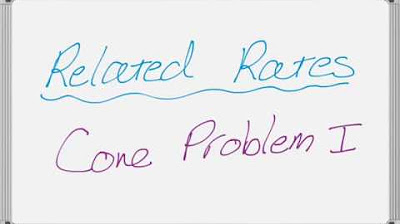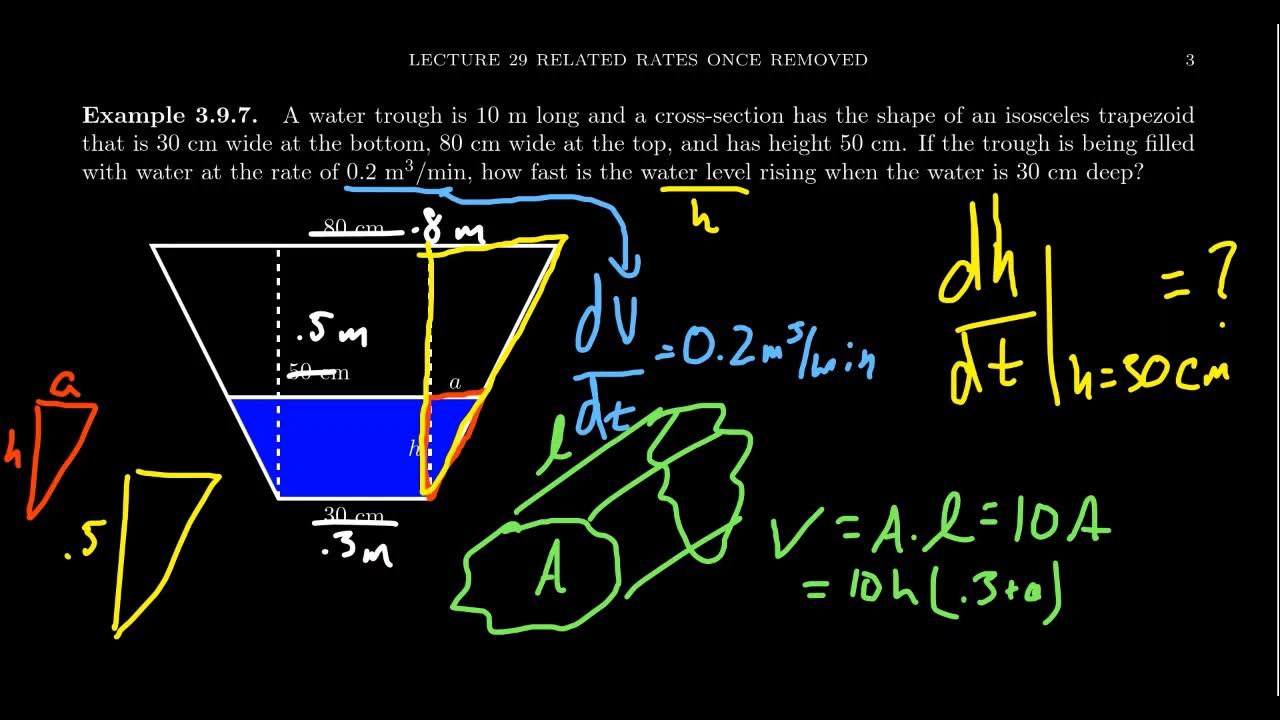Related Rates - Area of a Triangle
TLDRThis tutorial delves into related rate problems involving triangles, focusing on how to calculate the rate of change of a triangle's area given varying conditions. It first addresses a right triangle with a base and height that increase at different rates, using the product rule for differentiation. The example involves a triangle with sides of 8 cm and 10 cm, leading to a calculation of the area's rate of change in square centimeters per minute. The tutorial then explores a generic triangle with fixed side lengths and a varying angle, using the formula for the area involving sine and applying the chain rule to find the rate of area change in square meters per minute. The examples provided offer clear, step-by-step methods for solving related rate problems in the context of triangles.
Takeaways
- 📐 The tutorial focuses on related rate problems involving triangles, specifically how changes in side lengths or angles affect the area of a triangle.
- 📈 For a right triangle with a base increasing at 3 cm/min and height at 5 cm/min, the area's rate of change is determined by differentiating the area formula (1/2 * base * height) with respect to time.
- 🔄 The product rule is used for differentiation, which states that the derivative of a product of two functions is the derivative of the first function times the second function plus the first function times the derivative of the second function.
- 📌 At a specific moment when the base is 8 cm and the height is 10 cm, the area's rate of change (dA/dt) is calculated to be 35 square centimeters per minute.
- 🔽 Units for the rate of change of area (dA/dt) are derived from the units of the sides (centimeters) and the units of area (square centimeters), resulting in square centimeters per minute.
- 🔶 In a generic triangle with fixed side lengths, the area is given by the formula: Area = 1/2 * a * b * sin(C), where a and b are the side lengths and C is the angle between them.
- 🌀 When the angle C between two fixed sides is changing at a rate of 0.15 radians/min, the sides a and b are treated as constants, and their derivatives with respect to time (da/dt and db/dt) are zero.
- 📐 The rate of change of the area in the generic triangle is found by differentiating the area formula and applying the chain rule to the sine function, which involves the derivative of the angle (cosine of C) times the rate of change of the angle (dC/dt).
- 📊 Upon calculation, the area of the generic triangle is found to be increasing by 1.5 square meters per minute when the angle between the two sides is pi/3 radians.
- 🕰️ The concept of related rates can be applied to various geometric shapes to determine how quickly a certain property, such as area, changes over time due to variations in dimensions or angles.
- 👀 Understanding related rates is crucial for solving problems in calculus and has practical applications in fields such as physics and engineering where rates of change are significant.
Q & A
What is the main topic of the tutorial?
-The main topic of the tutorial is related rate problems as they pertain to triangles.
How fast is the base of the right triangle increasing?
-The base of the right triangle is increasing at a rate of 3 centimeters per minute.
At what rate is the height of the right triangle increasing?
-The height of the right triangle is increasing at a rate of 5 centimeters per minute.
What is the formula used to calculate the area of a right triangle?
-The formula used to calculate the area of a right triangle is one half times base times height (1/2 * base * height).
When the base and height are 8 centimeters and 10 centimeters respectively, how fast is the area of the triangle changing?
-The area of the triangle is changing at a rate of 35 square centimeters per minute when the base and height are 8 centimeters and 10 centimeters respectively.
What is the unit for the rate of change of the area?
-The unit for the rate of change of the area is square centimeters per minute.
What are the two fixed side lengths of the generic triangle in the second problem?
-The two fixed side lengths of the generic triangle in the second problem are 5 meters and 8 meters.
What is the formula for the area of a generic triangle?
-The formula for the area of a generic triangle is one half times side a times side b times the sine of angle c (1/2 * a * b * sin(c)).
How fast is the angle between the two fixed sides of the triangle changing?
-The angle between the two fixed sides of the triangle is changing at a rate of 0.15 radians per minute.
How much does the area of the triangle increase by every minute according to the second problem?
-The area of the triangle increases by 1.5 square meters every minute according to the second problem.
What would be the increase in the area of the triangle after 10 minutes?
-The area of the triangle would increase by 15 square meters after 10 minutes.
Outlines
📐 Related Rate Problems - Right Triangle Area
This paragraph introduces a tutorial focused on related rate problems concerning triangles, specifically a right triangle. The scenario involves the base and height of the triangle increasing at rates of 3 cm/min and 5 cm/min, respectively. The task is to determine how fast the area of the triangle is changing when the base and height are 8 cm and 10 cm. The explanation includes drawing the triangle, explaining the formula for the area of a right triangle (1/2 * base * height), and using differentiation with respect to time to find the rate of change of the area (da/dt). The process involves differentiating the equation using the product rule and plugging in the given values to calculate da/dt as 35 square centimeters per minute.
📐 Triangle Area Change with Varying Angle
The second paragraph discusses a problem involving a generic triangle with two fixed side lengths of 5 meters and 8 meters and a varying angle between them. The angle is increasing at a rate of 0.15 radians per minute. The goal is to find out how fast the area of the triangle is changing when the angle is pi/3 radians. The area formula for a generic triangle is given as 1/2 * a * b * sin(c), where a, b, and c represent sides and angle c is the angle between sides a and b. The summary explains that since sides a and b are constants, their derivatives with respect to time are zero, simplifying the differentiation process. The derivative of the sine function is used, applying the chain rule to find the rate of change of the area. The final calculation results in an area increase of 1.5 square meters per minute.
Mindmap
Keywords
💡Related Rate Problems
💡Right Triangle
💡Area
💡Differentiation
💡Product Rule
💡Chain Rule
💡Rate of Change
💡Centimeters and Meters
💡Trigonometry
💡Cosine Function
Highlights
The tutorial focuses on related rate problems involving triangles, providing a comprehensive explanation of how to tackle such mathematical challenges.
A right triangle's base is increasing at 3 cm/min, and its height at 5 cm/min, offering a real-world scenario for the application of related rates.
The area of a right triangle is calculated as 1/2 * base * height, a fundamental formula used to solve the problem.
The rate of change of the area of the triangle is found by differentiating the area formula with respect to time, showcasing the use of calculus in solving real-world problems.
When the base and height of the triangle are 8 cm and 10 cm respectively, the calculation of the rate of change of the area is demonstrated.
The use of the product rule in differentiation is explained, which is crucial for finding the rate of change when dealing with variables that are products of other variables.
The calculation results in a rate of change of the area (da/dt) of 35 square centimeters per minute when the base and height are at their given lengths and rates.
The units for the rate of change of the area are explained, emphasizing the importance of unit consistency in mathematical problems.
A second problem involving a triangle with fixed side lengths and a changing angle is introduced, highlighting the versatility of the related rates concept.
The area of a generic triangle is given by the formula 1/2 * a * b * sin(c), which is different from that of a right triangle and is essential for solving the second problem.
The angle between two fixed sides of the triangle is increasing at a rate of 0.15 radians per minute, which is the given information for the second problem.
Since the sides of the triangle are of fixed length, their rates of change are zero, simplifying the problem and focusing on the changing angle.
The derivative of the area formula with respect to time is calculated, applying the chain rule and the derivative of sine as cosine.
The area of the triangle is found to be increasing by 1.5 square meters per minute, a clear and practical result of the related rates problem.
The final answer is presented with a clear explanation of the units involved, reinforcing the concept of unit consistency and its importance in problem-solving.
The tutorial concludes by summarizing the process of finding the rate of change of an area for both right and generic triangles, providing a valuable resource for viewers.
Transcripts
5.0 / 5 (0 votes)
Thanks for rating:





